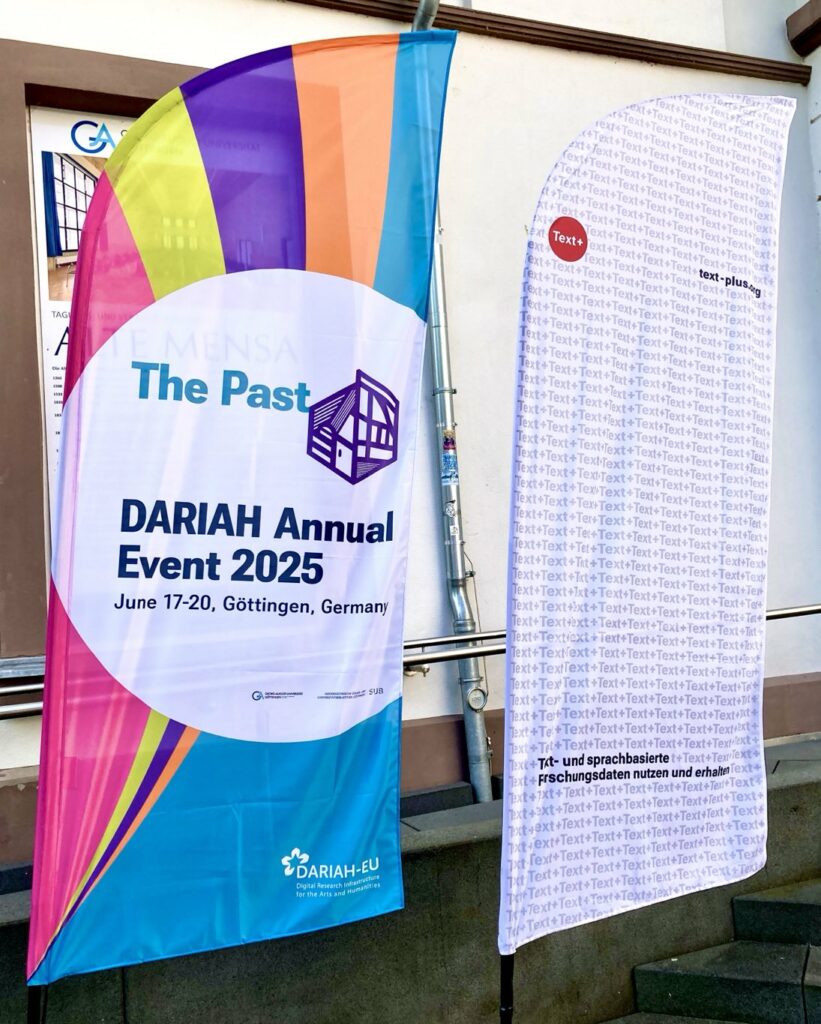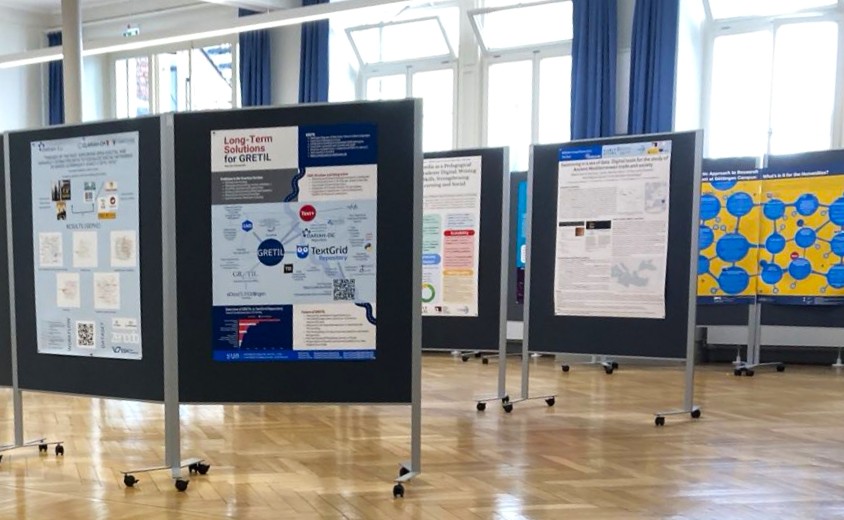Rachel McCarthy, PhD Researcher, University College Cork (CASCADE)
We’re excited to present the first of a special four-part blog series featuring insights from DARIAH-IE’s 2025 Early Career Researcher Bursary awardees.
DARIAH-IE was delighted to be able to support four Early Career Researchers to attend the DARIAH Annual Event, which took place in Göttingen, Germany in June 2025. The event was attended by almost 200 participants from across Europe, with 20 presentations, plus posters, over the course of the 3 days. As well as attending the event and benefiting from the networking and learning it offered, the awardees were given the opportunity to provide a short blog about their own work to share with fellow Irish Digital Humanities researchers on the DARIAH-IE website. These blog posts will be published every fortnight for the next few weeks.
Blog post by Rachel McCarthy, PhD Researcher, University College Cork (CASCADE)
Irish literature has long been a dynamic reflection of national identity, shaped by complex history, linguistic traditions, and shifting cultural priorities. My PhD research, “Measuring Change in Irish Literature”, sits at the intersection of literary studies and computational analysis. As part of the “CASCADE” MSCA Doctoral Network (www.horizoncascade.net) this project uses tools from cultural analytics and natural language processing (NLP) to investigate how Ireland’s literary canon has evolved – conceptually, stylistically, and thematically – over time.
The project is situated within the field of Digital Humanities, which brings computational methods into dialogue with humanistic inquiry. My goal is not to replace traditional literary analysis, but to augment it by scaling up our view: instead of close reading a handful of texts, I analyse hundreds of works, asking large-scale questions about language, meaning, and influence across decades and generations.
At the core of my research is a desire to understand how semantic and conceptual changes shift over time within the Irish literary canon. What topics dominate during certain historical periods? Which disappear, and which resurface in new guises? Using word embeddings and language models trained on a corpus of Irish literary texts, I track changes in word meanings and themes – such as how the language of conflict, religion, or gender evolves from the early 18th century to the present day.
Another strand of the research focuses on authorial language and stylistic patterns. By analysing linguistic features across works by different authors and generations, I examine both intragenerational and intergenerational continuities. How do writers from the same era resemble or diverge from each other in tone, syntax, or vocabulary? How does the literary voice of one generation echo, or reject, the one before?
The project also pays close attention to the impact of external events – wars, economic crises, technological changes, etc. – on literary production. While these “ad hoc” historical moments often seem to intrude from outside the text, I investigate how they become embedded in the Irish literary scene. For example, how did the language of trauma change after the Troubles? Or how did postcolonial independence reshape the way “Irishness” is written and imagined?
By blending computational approaches with literary theory, this research contributes to ongoing conversations about canon formation, cultural memory, and national identity. It invites us to reconsider the Irish literary canon not as a static collection of revered texts, but as a living, shifting network of meaning, one that responds to – and helps to shape – the cultural, political, and emotional landscape of its time.
Ultimately, “Measuring Change in Irish Literature” reflects the ethos of Digital Humanities: to bring new methods to bear on enduring questions, and to open up fresh perspectives on texts we thought we knew. As we continue to digitise, analyse, and reinterpret our cultural heritage, projects like this help us see literature not just as an archive of the past, but as a dynamic map of cultural change.
Rachel also wrote about her experiences of attending the DARIAH Annual Event on the CASCADE website, the post is reproduced here with permission.
Notes from DARIAH by Rachel McCarthy

Earlier this June, I had the pleasure of attending the 2025 DARIAH Annual Event in the historic city of Göttingen, Germany. Set in the impressive Göttingen State and University Library (SUB) and Alte Mensa, the conference brought together a vibrant community from the fields of digital humanities, cultural heritage, and data science under the unifying theme: “The Past”. Spanning four dynamic days, the event provided an inspiring forum for exploring how the digital humanities are reshaping our relationship with historical knowledge – from immersive archives and machine learning to educational games and inclusive metadata.
Of course, the primary debate focused on the place and role of artificial intelligence in digital humanities today. Dr Andrea Scharnhorst’s presentation, “Archiving for the Future Past – Multimodality and AI – Challenges and Opportunities”, explored how to enhance digital archival infrastructures with AI-driven solutions. Drawing on open-source infrastructures like the Dataverse project, the team demonstrated how innovative tools like Ghostwriter AI can support more inclusive annotation, metadata enrichment, and access across sensory modalities. Beyond the technical dimension, the presentation emphasized the importance of collaborative knowledge organization and the need to support smaller or vulnerable data communities, ensuring that the diversity of cultural expression is not lost to time – or technology. As Dr Scharnhorst explained, while AI will most certainly change human behaviour, it does not have to erode our humanity.

In another fascinating session entitled, “AI4LAM: A Collaborative Network for Reliable and Trustworthy Use of AI in Libraries, Archives, and Museums’ Historical Collections”, Dr Ines Vodopivec offered us a reality check: “It’s no longer about whether we use AI. Now, it’s about how we use it”. Her talk emphasized ethical, responsible integration of AI into archival institutions, highlighting the goal of AI4LAM in fostering a framework for organizing, sharing, and elevating the knowledge about and use of AI as well as advocating for reliable and trustworthy AI tools and services. This wasn’t just a plea to develop a common dialogue environment for implementing AI, it was an invitation to shape the tools that are already shaping us.
Equally compelling was the Dr Tianyu Yang’s presentation, “Content Analysis of Historical Datasets with Large Multi-modal Models”. This talk addressed the persistent challenges in digitizing and annotating historical documents – something which I have come up against in my own research multiple times. While OCR has long been the backbone of document transcription, its effectiveness drastically drops when applied to historical materials due to degraded quality and archaic layouts. The session explored how emerging Large Multi-modal Models, which combine the strengths of pretrained visual encoders with large language models like GPT-4 and LLaMA, can now step in to enhance this process. These models exhibit impressive capabilities, automatically generating image captions and transcriptions without the need for extensive domain-specific training. Their integration into digitization workflows offers a scalable path forward: reducing manual labour, increasing the discoverability of visual content, and significantly broadening access to historical archives. In essence, this form of AI model represents a new frontier in automated historical content enrichment, bridging the gap between text and image, and between computational efficiency and cultural preservation.
Whether over coffee at the poster session, touring the historic city centre, or chatting at the social dinner, one thing stood out: DARIAH’s strength is its people. From early-career researchers to seasoned infrastructure leads, everyone was generous with ideas and eager to collaborate. The community spirit was as memorable as the presentations themselves and the conference offered a compelling look at how the digital humanities are transforming our engagement with the past – not just through innovation, but through reflection, collaboration, and care.
The 2025 DARIAH Annual Event made it abundantly clear that the digital humanities are not simply adopting new technologies such as AI out of necessity; they are actively shaping them to serve humanistic inquiry. Whether through inclusive infrastructure design, critical engagement with AI, or creative reinterpretations of the past, this community is working to ensure that the digital future remains grounded in cultural context and human connection. I’m already looking forward to DARIAH 2026 and the next chapter in this evolving conversation.
Biographical note
Rachel McCarthy is a PhD researcher at University College Cork, where she previously earned a bachelor’s degree in ‘Digital Humanities and Information Technology’. After completing a master’s degree in ‘Digital Text Analysis’ at the University of Antwerp, she now focuses on computational literary studies. Her research involves using techniques such as stylometry, natural language processing, and language models to investigate authorship attribution and writing styles, and to track semantic changes in texts beyond traditional reading methods. Passionate about advancing text analysis, she aims to uncover new insights into literary and historical texts using digital methodologies.

